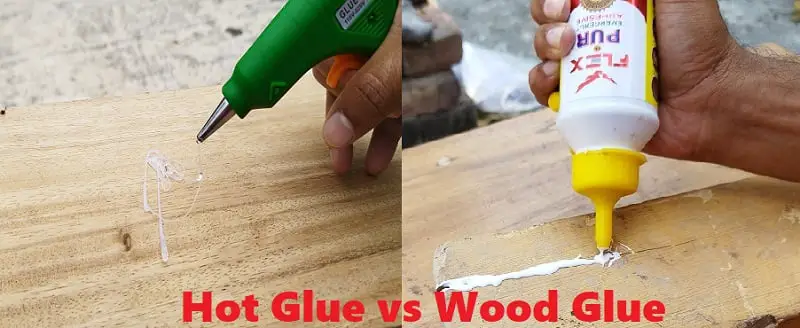
When you have hot glue at home, you may want to use it for a woodworking project and avoid going outside to purchase wood glue. But can you use hot glue instead of wood glue? Are there any differences between hot glue vs wood glue? If yes, then what are the differences?
The main difference between hot glue and wood glue is strength. Wood glue bonds pieces of wood strongly, which makes them tough to separate. Hot glue has less strength and may work well only by attaching small pieces of wood. Several other differences make them suitable for different purposes.
Now the obvious question is when you should use wood glue and when hot glue. Let’s learn more about the differences between wood glue and hot glue to make a decision about your next project.
What is hot glue? Basics, Benefits, and Problems
Hot glue is a form of thermoplastic adhesive that is available as cylindrical sticks suitable for use with a hot glue gun. The sticks melt in the glue gun and come out of the nozzle for application. Due to its melting nature, hot glue is also known as Hot Melt Adhesive (HMA).
You can use hot glue on different surfaces such as plastic, wood, paper, fabric, and metal. It’s a great choice for small home improvement projects and crafting.
Problems:
- The hot glue is not waterproof.
- Its high temperature can burn your skin during work.
What is wood glue? Basics, Benefits, and Problems
Wood glue is a strong adhesive that creates a strong bond between multiple pieces of wood. The components in the wood glue differ based on the type. Polyvinyl acetate (PVA) is the most common wood glue, and others are hidden glue, epoxy, and polyurethane.
When it comes to woodworking, these glues are the best options. Some wood glues are so strong that if you try to separate the wood after gluing, it will break the wood boards.
Problems:
- They are only suitable for attaching wood.
Hot glue vs Wood glue: A demonstrative and determiner Comparison table
| Features | Hot glue | Wood glue |
| Strength | Average | Excellent |
| Durability | Average | High |
| Dry time | Low | Medium |
| Cleaning | Easy | Easy |
| Fumes | Mostly yes | Mostly no |
| Gap filling ability | Average | Good |
| Suitable with | Metal, glass, silicone, fabric, etc. | Wood |
| Price | Cheap | Expensive |
Hot glue vs Wood glue: Key differences that clear the Concepts

Both hot glue and wood glue have different characteristics that are good for different works. Our verdict on the following categories is based on working with wood.
1. Strength While attaching two things together
Who Wins? “Wood glue” for tough joining ability/Long time usage
Whenever you are using glue to attach two things together, strength is one of the most important factors. Woodworking requires strong bonds for long-term usage.
Hot glue melts and attaches to different materials strongly. It will work well in small woods. But its average strength can not hold heavy wood well. Even if you try to separate the smaller woods attached with hot glue, it will not be a tough job.
Wood glue is specially made for attaching different types of wood and has excellent strength. Polyurethane is one of the strongest wood glue, and PVA also performs amazingly. When it comes to strength, wood glue is way ahead of hot glue.
Wood glue strength (Amazing result) Video:
2. Faster Drying time (returns as a blessing in a hurry):
Who Wins? Hot glue: 1 to 10 minutes (less than wood glue)
If you are in a hurry, you may want to use glue that dries quickly. Depending on the temperature and types of materials, the drying time for both of these glues will vary.
Generally, wood glue takes around 5 to 20 minutes to dry and at least 24 hours to cure fully. You also need to clamp the wood before drying. Considering the curing time, it’s on the slower side.
Hot glue dries in as low as 1 minute and may take up to 10 minutes. After that, you can move the parts attached.
However, hot glue also needs curing time, which is usually less than 24 hours. In short, hot glue has a faster drying time than wood glue.
3. Usability for different wood joining projects
Who Wins? Wood glue covers a large area within a short time
Generally, you may think hot glue is easy to use with the handheld hot glue gun. That’s true, but for only small projects where you need to cover a smaller area. Only a limited amount of glue comes out of the nozzle, which is time-consuming.
You have no such problems with the wood glue. Take a bottle of wood glue and pour it onto the surface of the wood. Then spread the glue to the whole area and attach it. You can cover a large area within a very short period of time with wood glue.
4. Filling gaps (Which one works efficiently):
Who Wins? Wood glue: It is ideal for both small and large gaps in the wood.
Filling gaps is essential in woodworking for its porous nature. Hot glue can fill small gaps well. But when the gaps are larger, they may not work efficiently.
Wood glue is perfect for filling different sizes of gaps in the wood. Although, when the gaps are too large, you may need to add some sawdust for better results. Comparatively, wood glue is better than hot glue for filling gaps.
5. Safety concern: Wood glue or hot glue
Who Wins? Wood glue: It doesn’t have any adverse effects while used with careful hands
Most hot glue produces fumes that are a little bit toxic. The amount is too low and usually does not cause any problems unless you have respiratory problems.
Plus, as the glue is hot, it can burn your skin on contact. We recommend using masks and gloves while working with hot glue.
Wood glue does not produce many fumes and is mostly non-toxic. Moreover, you can spread the wood glue on the surface with bare hands.
Wood glue is safe to use, but remember to check the description of the package as some wood glue may include toxic chemicals.
6. Cleaning residues (after gluing touch)
Who Wins? Wood glue: pretty easy to clean with the scraper or wet cloth or diluted vinegar
After you attach the wood with glue, the cleaning part comes in. In the case of hot glue, you need to act instantly. That’s because they dry fast, and once they dry, you will have a hard time removing the residues.
Cleaning wood glue, on the other hand, is pretty easy. Use a scraper to remove the residues and pat the surface with a wet cloth to clean properly. If it feels sticky, you may use diluted vinegar for effective cleaning.
Best hot glue sticks that speak while gluing woods

If you want to use hot glue sticks for your next project, the following options are the best:
1. Gorilla Hot Glue Sticks
The Gorilla Hot Glue Sticks is one of the best hot glue sticks available on the market. It is flexible with different temperatures and can dry in as low as only 45 seconds. You can paint or sand on this hot glue without any problem.
The Gorilla Hot Glue packet includes 45 sticks, each 5 inches long, and has a .43-inch diameter. It is most suitable for metal and glass surfaces.
2. Surebonder CS15 CoolShot Low Temp Glue Sticks
You also can go for the Surebonder CS15 CoolShot Low Temp Glue Sticks. The best feature of this hot glue is that it has a low temperature, which means it will melt quickly and is safer to use.
This is the best option when you don’t need many sticks. It includes only 15 sticks per pack, and each one is 4 inches long. It is suitable for use with fabric, wood, foam, cardboard, and ribbon.
Best wood glue adhesive with massive performance
The following two wood glue can be the best choices for your next woodworking project:
1. Gorilla Wood Glue
Gorilla is the best brand for any glue type. The PVA-based Gorilla Wood Glue has a natural wood color and is suitable for hardwood, softwood, and natural wood. It creates strong bonds for woods with excellent adhesion strength.
The Gorilla Wood Glue takes around 20 to 30 minutes for clamping and 24 hours to cure. Plus, the glue is moisture-resistant and safe to use with no foaming.
2. Elmer’s E7310 Carpenter’s Wood Glue Max
The Elmer’s E7310 Carpenter’s Wood Glue is one of the best budget wood glues. It works superbly on heavy wood and is extremely durable. Plus, the wood glue is easy to clean with water.
Elmer’s Wood Glue is PVA based and has no toxic chemicals or harmful fumes. It is also sandable and paintable.
Hot glue: Why do I choose it for my wood project?
Although hot glue isn’t recommended for woodwork, you can use it when the work is small, and you already have some excess hot glue with you. Don’t forget to check the description if that’s suitable for woods.
We recommend using hot glue for smooth surfaces and materials such as metal, glass, silicone, vinyl, or wax. Hot glue is great for adhering to small items.
Wood glue: Why do I choose it for my wood project?

Wood glue has excellent adherence power that is said to be stronger than the wood itself. It is formulated to penetrate the wood fibers efficiently and create a super-strong bond.
Today, most woodworkers use wood glue as an alternative to screws. While screws leave gaps, wood glue fills them. That’s why we always prefer wood glue for joining wood pieces.
FAQs
1. Is hot glue better than wood glue?
Both hot glue and wood glue are good for serving their purposes. When it comes to woodworking, wood glue is obviously better. But for other materials such as metal, glasses, silicone, etc., hot glue is a better choice.
2. Will hot glue peel off wood?
If you want to remove hot glue from wood, let it dry first. Then rub the glue with acetone or rubbing alcohol, and the hot glue should peel off the wood pretty easily.
3. What glue do carpenters use?
Polyvinyl Acetone (PVA) wood glue is the most common type of wood glue that carpenters use. It has excellent adhesion power which makes it better than other wood glues. People often call the PVA wood glue the Carpenter’s glue.
4. Is wood glue stronger than screws?
Wood glue can create a stronger bond than screws. If you use wood glue, there is no need to use screws to attach the wood. Use screws only when you have a plan to disassemble the wood pieces in the future.
Hot glue vs wood glue: Ultimate Winners
So who wins the adhesive cup? Well, The above comparison between hot glue vs wood glue clearly shows that wood glue is the winner for woodworking projects.
They are easy to use and have superior strength. The only problem with wood glue is that it is not suitable for other surfaces.
Wood glue is slightly more expensive than hot glue but totally worth the price.



